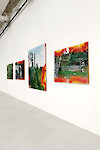












Mesa curandera
organization throughout contemporary history. In this way, his research in film has brought him to heavily charged locations such as Hiroshima, Chandigarh or even Brasilia. Today, it is the magical rites of healers on the Peruvian desert coast that interest the artist.
In 2015, he met the curandero José Levis Picon Saguma whose work inscribes itself in the continuity of Pre-Columbian healing rituals. His practice of curandero, a term which signifies “healer” in Spanish, can be included in the larger category of shamanism. During healing ceremonies, known as mesas, José Levis practices this form of vernacular medicine nearly in secret, in areas on the outskirts of towns. His most important plant is the San Pedro, a psychoactive cactus whose earliest ritual use goes back some 3000 years.
The practice of the curanderos interests Louidgi Beltrame above all as a form of post-colonial resistance. Its characteristic syncretism can be seen as an adaptive camouflage developed by the Andean population in order to survive first the Inquisition and then colonial repression. The current form of this traditional medicine is characterized by successive cultural influences that have been present in the Andean territory. Highlighting in this way the persistence of Pre-Hispanic elements related to shamanistic practices which are particularly based on the use of psychotropic plants.
In order to film these ceremonies without compromising their unfolding, Louidgi Beltrame had his camera outfitted with a specially designed infrared lens. Unlike the aesthetic of used by surveillance cameras, the pinkish... [lire plus]
Ce projet a été sélectionné par la commission mécénat de la Fondation Nationale des Arts Graphiques et Plastiques qui lui a apporté son soutien.
Lauréat du programme "hors les murs" de l'Institut français
